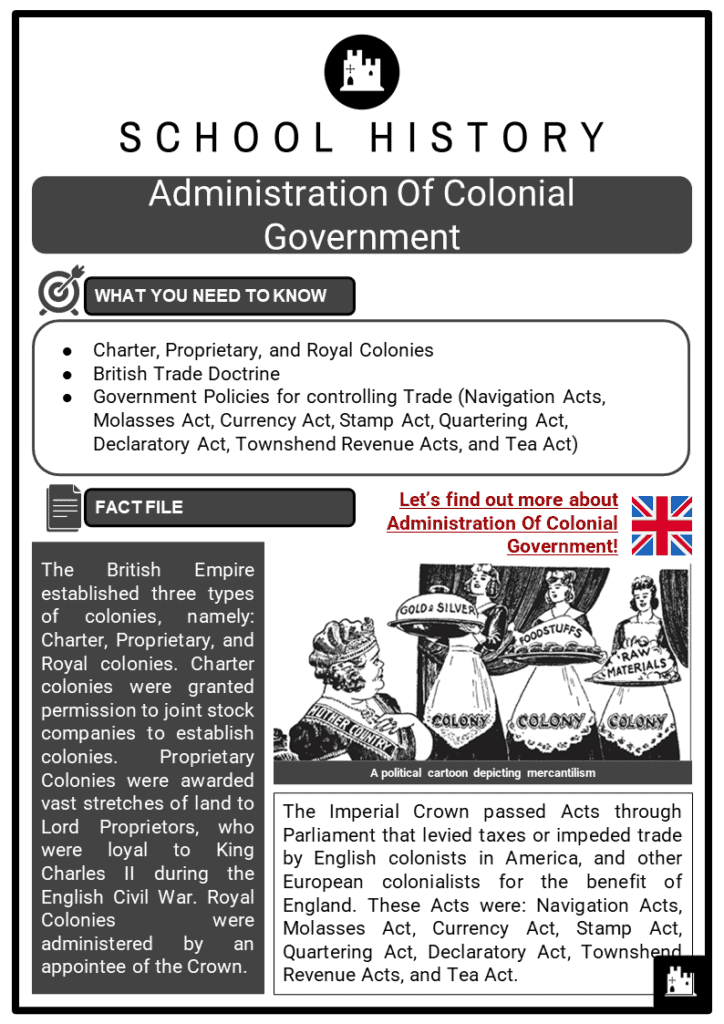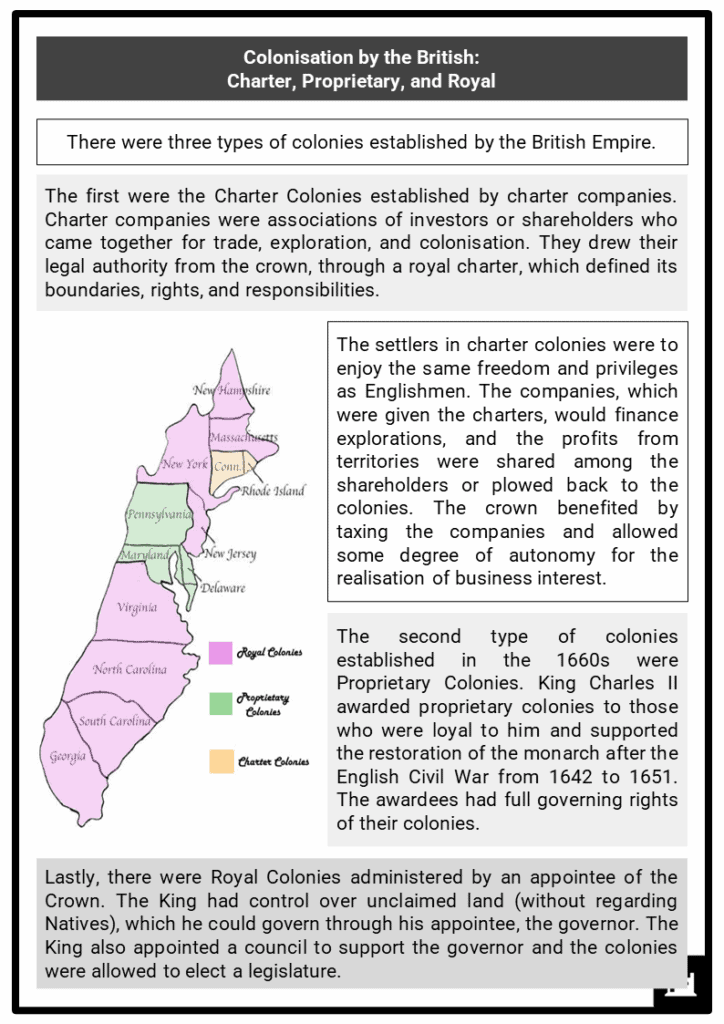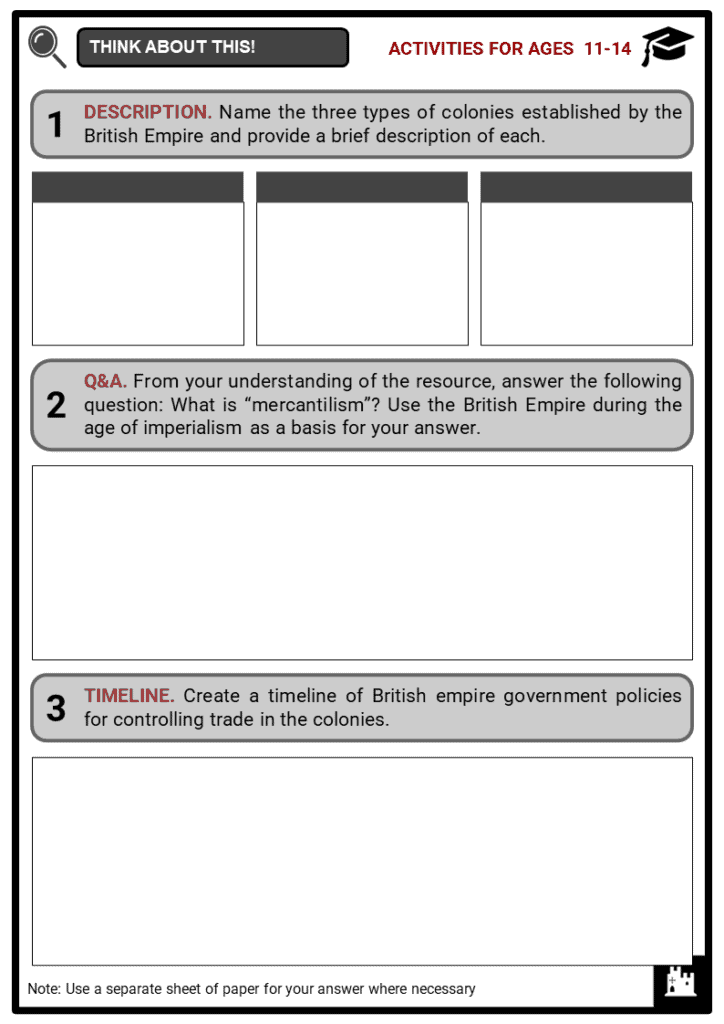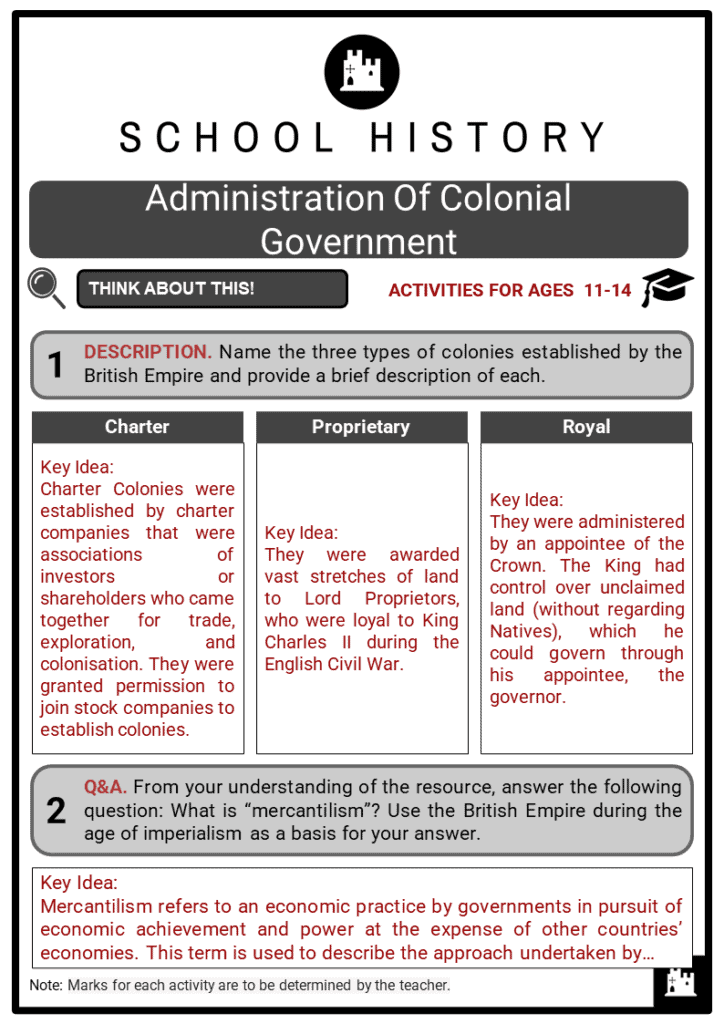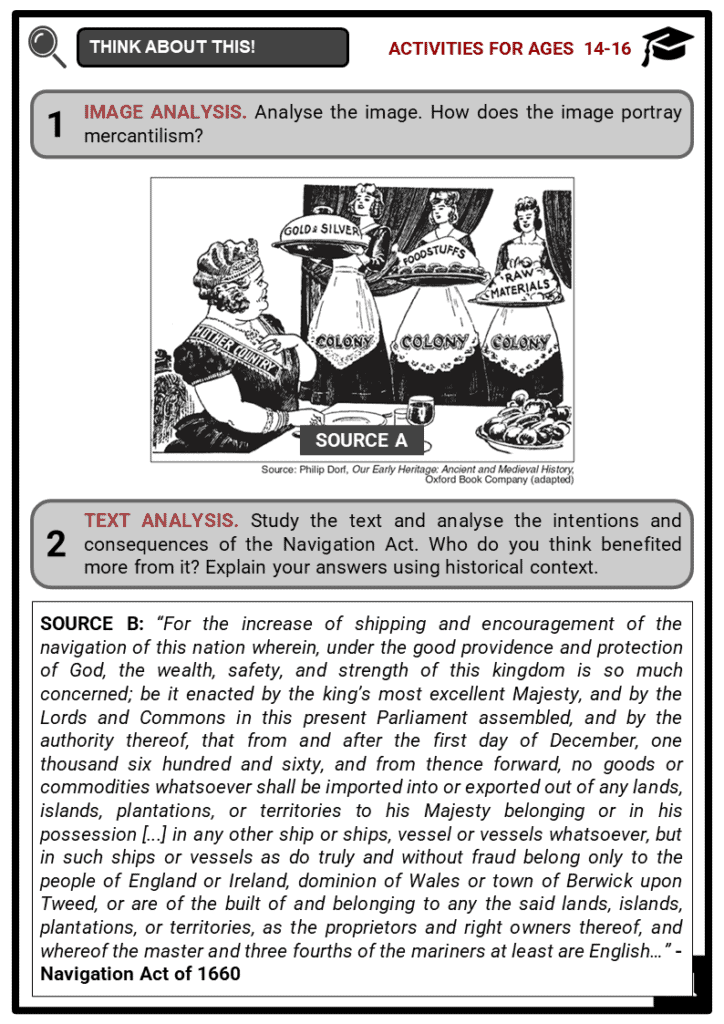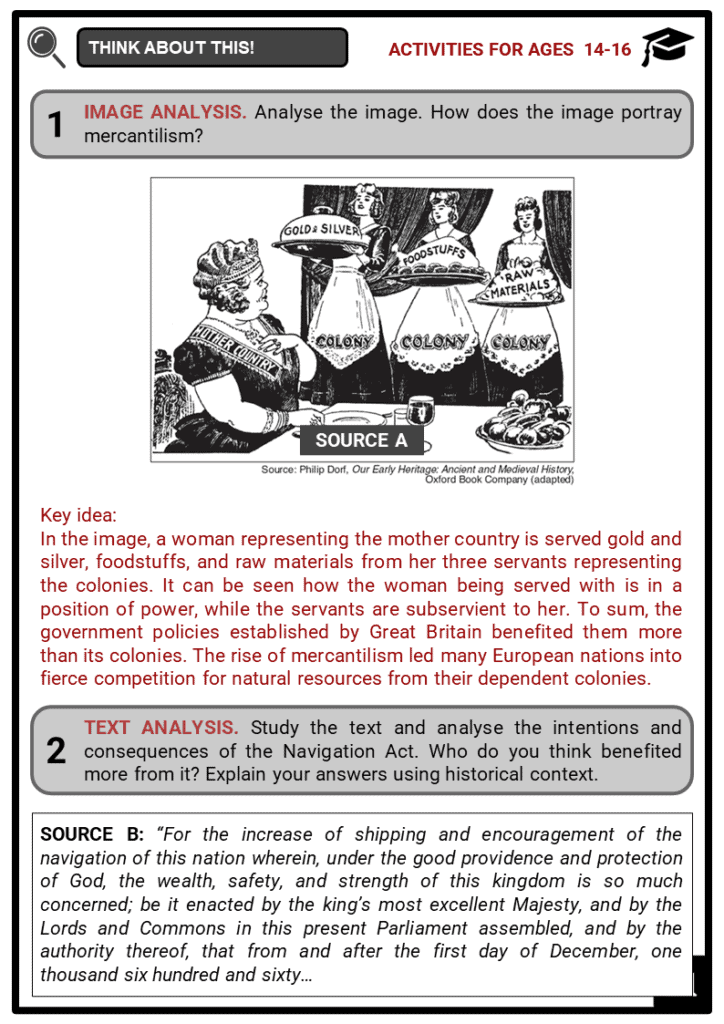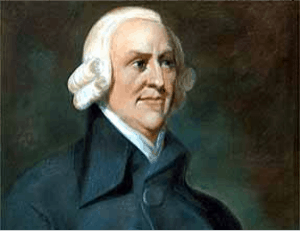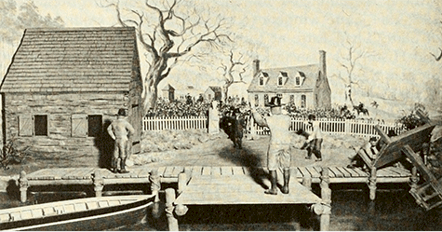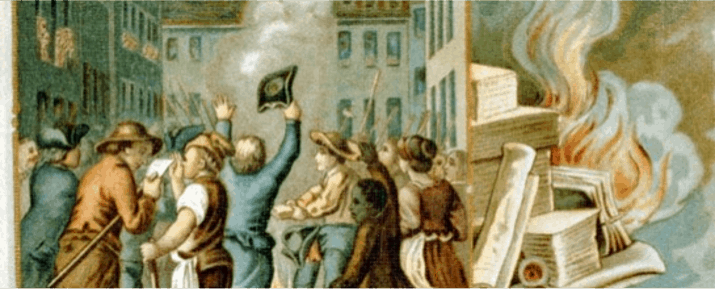Download Administration Of Colonial Government Worksheets
Do you want to save dozens of hours in time? Get your evenings and weekends back? Be able to teach Administration Of Colonial Government to your students?
Our worksheet bundle includes a fact file and printable worksheets and student activities. Perfect for both the classroom and homeschooling!
Table of Contents
Add a header to begin generating the table of contents
Summary
- Charter, Proprietary, and Royal Colonies
- British Trade Doctrine
- Government Policies for controlling Trade (Navigation Acts, Molasses Act, Currency Act, Stamp Act, Quartering Act, Declaratory Act, Townshend Revenue Acts, and Tea Act)
Key Facts And Information
Let’s find out more about Administration Of Colonial Government!
- The British Empire established three types of colonies, namely: Charter, Proprietary, and Royal colonies. Charter colonies were granted permission to joint stock companies to establish colonies. Proprietary Colonies were awarded vast stretches of land to Lord Proprietors, who were loyal to King Charles II during the English Civil War. Royal Colonies were administered by an appointee of the Crown.
- The Imperial Crown passed Acts through Parliament that levied taxes or impeded trade by English colonists in America, and other European colonialists for the benefit of England. These Acts were: Navigation Acts, Molasses Act, Currency Act, Stamp Act, Quartering Act, Declaratory Act, Townshend Revenue Acts, and Tea Act.
Colonisation by the British: Charter, Proprietary, and Royal
- There were three types of colonies established by the British Empire.
- The first were the Charter Colonies established by charter companies. Charter companies were associations of investors or shareholders who came together for trade, exploration, and colonisation. They drew their legal authority from the crown, through a royal charter, which defined its boundaries, rights, and responsibilities.
- The settlers in charter colonies were to enjoy the same freedom and privileges as Englishmen. The companies, which were given the charters, would finance explorations, and the profits from territories were shared among the shareholders or plowed back to the colonies. The crown benefited by taxing the companies and allowed some degree of autonomy for the realisation of business interest.
- The second type of colonies established in the 1660s were Proprietary Colonies. King Charles II awarded proprietary colonies to those who were loyal to him and supported the restoration of the monarch after the English Civil War from 1642 to 1651. The awardees had full governing rights of their colonies.
- Lastly, there were Royal Colonies administered by an appointee of the Crown. The King had control over unclaimed land (without regarding Natives), which he could govern through his appointee, the governor. The King also appointed a council to support the governor and the colonies were allowed to elect a legislature.
- The governor had control of taxes and expenditure apart from those relating to himself like salary and benefits, which required the approval of assemblies. The Crown had more control over royal colonies as compared to the other two types. When charter colonies became unruly, the crown would withdraw their charters and convert them to royal colonies.
- Maryland, Delaware, and Pennsylvania were proprietary colonies. Massachusetts, Connecticut, and Rhode Island were charter colonies, and New Hampshire, New York, New Jersey, Virginia, North and South Carolina, and Georgia were royal colonies.
British Trade Doctrine
- Adam Smith, a social philosopher and political economist, coined the term “mercantilism” in his book “The Wealth of Nations”, to refer to an economic practice by governments in pursuit of economic achievement and power at the expense of other countries’ economies.
- This term is used to describe the approach undertaken by the British Empire in the age of imperialism where the focus was on increasing exports, expanding the British markets through the establishment of colonies, and engaging with other European players and the importation of raw materials for economic growth.
- The Crown applied taxes and duties to enforce the system and benefit from the colonies.
Government Policies for controlling Trade: Barriers, Tariffs, and Subsidies
- To achieve the objective of expanding exports and restricting imports to raw materials, England applied some laws and regulations. The laws passed by the British Empire resulted in strained relations between the colonists and the Empire with the cumulative effect being the Revolution.
The Navigation Acts
- The Navigation Acts (also called Acts of Trade and Navigation) were mainly revenue-raising policies that imposed taxes and duties on products from the colonies.
- In 1651 and 1660, the British Empire passed another Navigation Act, whose main effect was to limit colonial trade to England and reduce England’s dependence on imported goods. The Dutch were the greatest trade rivals of the British and the 1651 Act required that all products for trade between England and the colonies were to be transported by either the English ships or the ships of the colonies, resulting in the Anglo-Dutch War of 1652.
- The Navigation Act of 1660 and the subsequent Acts of 1662, 1663, 1670, and 1673 introduced and tightened the practice of enumeration. Products such as sugar, indigo, and tobacco were enumerated and thus, to be shipped only within the empire. Moreover, trade of such products with a destination outside the British Empire had to go through England for the imposition of taxes and levies.
- Cotton, wool, rice, ginger, and molasses were enumerated in the 18th century. Non-enumerated goods were allowed to go on non-English ships directly to foreign ports. In 1664 onwards, English colonies could only receive English products via England. Scotland and Ireland were included in the English privilege in 1707 and 1779 through the Act of Union.
- The colonies were negatively affected by the trade restrictions, mainly North Carolina, which resorted to smuggling tobacco and trading with Massachusetts and Rhode Island colonies until the passage of the Plantation Duty Act of 1673, which imposed the usual English duty for products as though shipped from England.
- The Navigation Acts also resulted in the Culpeper’s Rebellion from 1677 to 1678 against the Proprietor of Albemarle County because of the limitation against free trade.
Molasses Act 1733
- The Molasses Act was a trade barrier policy against exports from the French and Spanish Islands of Martinique and Santo Domingo by imposing a duty on the products from these regions.
- The intention was to protect the British West Indies exports to the American colonies. Corruption and illegal trade became rife and collection from 1738 to 1741 reduced by a quarter of what was collected in the first year of the Act.
- The Act was repealed by the Sugar Act 1764, which in addition to imposing the duty, compelled vessels to transport cargo through the port of Britain before transporting to the colonies. The Act also included in its ambit of products wine from Madeira, Azores, and the Canary Islands as well as hides, skins, potash, and other products. The Vice-Admiralty Courts were used to enforce the laws.
Currency Act 1751
- Colonial governments suffered a shortage of currency, and it was illegal to mint money. Therefore, they used bills of credit issued in place of the sterling or silver to demonstrate government indebtedness to the holder.
- They were based on the value of mortgaged land whose value was not standardised, resulting in some problems, particularly inflation and the depreciation of silver that increased England’s debt burden especially when more paper money was printed than collected in the form of taxes.
- The Currency Act 1751 prohibited the issuance of bills of credit in the New England colonies, namely: Rhode Island, Massachusetts Bay, New Hampshire, and Connecticut. A subsequent Act of 1764 was passed affecting all other territories.
Stamp Act 1765
- The Stamp Act intended to raise money by making it a requirement for the purchase of stamps for public and legal documents including newspapers, pamphlets, almanacs, playing cards, and newspaper advertisements.
- Violators were taken to the Vice-admiralty court for persecution even though it had no jury and its jurisdiction was limited to maritime issues violating the right to trial by jury.
- The tax was the first explicit taxation upon the colonists. Previous taxes hid under the guise of regulating trade and not overtly for raising revenue from the people for the Empire. The resistance movements to this tax were a precursor to the American Revolution War.
Quartering Act 1765
- The Quartering Act required the assemblies in the colonies to fund the daily sustenance in the form of housing, food, and drink of British troops stationed in the territories.
- It further required the assemblies to improve military living conditions without increasing the Crown's cost of maintaining the forces. In 1766, the New York assembly refused to raise the money needed and in the following year, the English parliament suspended the assembly subject to its compliance.
Declaratory Act 1766
- The Declaratory Act 1766 may have repealed the Stamp Act 1765, but it also reiterated that colonies were subordinate and dependent to the Imperial Crown and Parliament of Britain.
Townshend Revenue Acts 1767
- The Townshend Revenue Acts imposed taxes on a list of 72 items including tea, grass, and paper. The revenue raised from the tax was used to provide salaries to colonial officers and its administration.
- It authorised the Supreme Court to issue writs of assistance for violators, established the American Customs Board, and expanded Vice Admiralty Courts. There was widespread resistance against this Act, which eventually led to the Boston Massacre during which five colonists were shot dead when the British Army opened fire during a riot.
Tea Act 1773
- The Tea Act of 1773 gave the East India Company exclusive license to import and distribute tea to the American colonies. Tea was sold in America at 10s per pound, half its previous price and less than the cost of smuggled tea.
- Despite the economic benefit to the consumers of tea, the law damaged the position of independent shippers, smugglers, and local shopkeepers. In December 1773, an event known as the Boston Tea Party happened wherein colonists disguised as Mohawk Indians raided British ships and dumped 342 chests of tea into the Boston harbor.
- The Acts passed by the Crown stirred in the colonists a sense of American nationalism, and the resistance movements in Boston precipitated the American Revolution.
Image sources:

